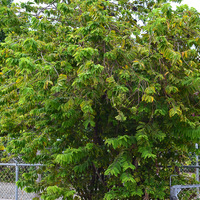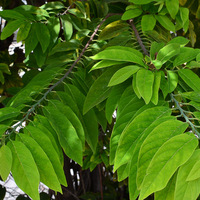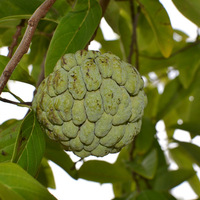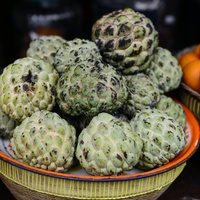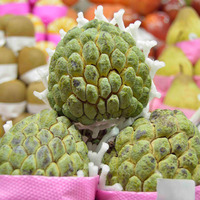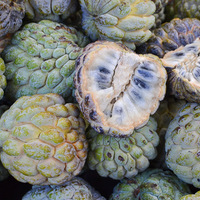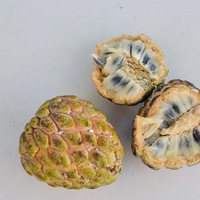Common name: Sweetsop
Other common names: Sugar Apple
Description
Sweetsop or Sugar Apple is a custard apple relative originating from lowland Central America and the Caribbean. Widely introduced worldwide, it is now grown for its fruit in South America, Africa, the Middle East, Southeast Asia, India, and Oceania.
Sweetsop is typically a shrub or small tree 3 to 5 m (10 to 15 ft) tall, with one or more upright stems. These support long, lateral branches forming a wide-spreading, roundish canopy. The bark is grey and relatively smooth, though leaf scars sometimes roughen it.
Leaves are oblong to lance-shaped, 7 to 15 cm (2.5 to 6 in ) long, dull green and arranged alternately along the branches. These fall off the plant in the dry season to conserve water, leaving the branches bare to mostly bare until the rainy season, which arrives with spring in its native range. Besides encouraging new leaves to grow, the rains induce flowering.
Flowers are oblong, 2 to 4 cm (0.8 to 1.5 in) long and consist of two sets of three petals, the inner set pale-yellow, the outer set yellow-green and leathery, and none fully opening. They are bi-sexual, with female and male parts and hang on short stalks from the branches, attracting pollinating insects.
The fruit is heart-shaped, green, less commonly purple and has peel covered in lumps or bumps arranged in a scale-like pattern. The bumps on young fruit are close together, but as the fruit ripens, they ease apart and change colour. On green-fruited varieties, they become medium green to pale blue-green and, between them, creamy-orange. They are usually harvested when mature but still firm and range from 6 to 10 cm (2.5 to 4 in) in diameter or 200 to 400 grams (7 to 14 ounces) in weight.
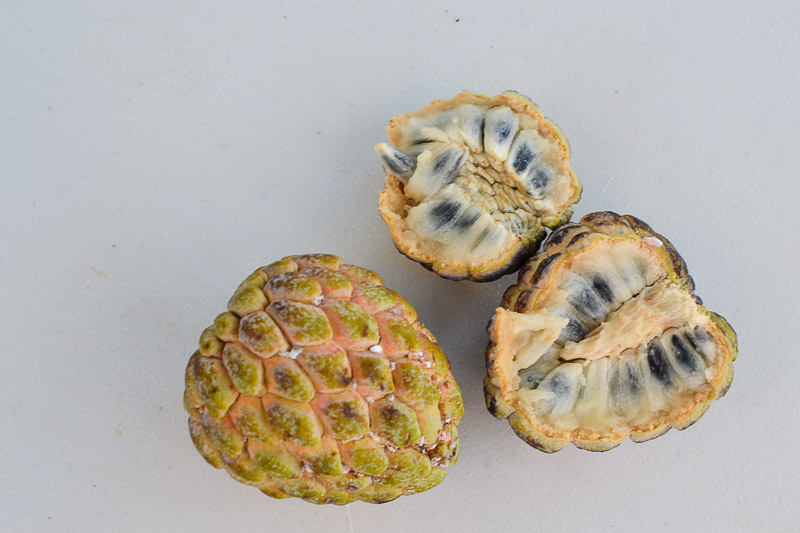
Use
The fruit is fully ripe when soft to the touch and easily torn apart or sliced open with a knife and is commonly eaten fresh out of hand. The pulp is separated into segments, each with a large glossy brown seed at the centre, and is sucked away in the mouth, leaving the seed behind, which is then usually spat out and discarded.
The pulp, although scant, is aromatic, with a custard-like, slightly granular texture and an agreeable sub-acid, somewhat musky flavour. Care is taken to avoid swallowing the seed, which some consider a poison risk if ingested.
The powdered seed are used as an insecticide and parasiticide in some regions, especially against lice infestation. The seed oil has also been shown to have an insecticidal effect on some insects.
Health use
The fruit pulp contains good amounts of Potassium and Vitamin B1 (Thiamine).
Climate
Sweetsop is the most drought tolerant of the cultivated custard apples, growing and fruiting best in sub-humid to humid subtropical and tropical climates, generally frost-free areas with annual lows of 14 to 25°C, annual highs of 24 to 35°C, annual rainfall of 700 to 4500 mm and a dry season of 2 to 8 months.
Sweetsop may fail to produce flavoursome fruit in high-elevation areas, generally where the average low of the warmest month is below 18°C (64°F).
Growing
New plants are usually started from seed, which remain viable for years. However, they are slow to germinate, though they can be sped up by soaking them in water for a few days.
Sweetsop performs best on free-draining loam and sand soils of a slightly acid to alkaline nature, generally with a pH of 6.5 to 8.0 and on sites with full sun exposure.
The root system is shallow, but the plant is surprisingly drought-tolerant due to its habit of shedding its leaves during dry periods. It does well on thin soils, including gravel and stony soils, provided the roots are well mulched. It has poor tolerance to clayey, slow-draining, waterlogged or saline soils.
Hand pollinating is recommended to increase fruit set and yield, which can be low due to the female and male parts of the flower maturing at different times of the day. Yields of 25 to 50 fruit per tree per year have been recorded for trees in southern Florida, which is considered low and probably results from poor pollination due to the absence of the tree's native pollinators.
Problem features
The fruit contain many seed, some scattering beneath the tree when over-ripe fruit fall and splatter on the ground. Animals also disperse seed, including birds that peck out the pulp and carry the seed afar.
It is listed as a weed in at least one reference publication and is recorded as naturalised in more than one country, including Australia, Brazil and the United States (Florida). However, there does not appear to be any record of it as a serious weed anywhere in the world. It is assessed as a low weed risk species for Hawaii by the Hawaii Pacific Weed Risk Assessment (HPWRA) project.
The leaves and ripe fruit fall to the ground, creating litter. The seed has poisonous properties, including being a strong irritant to the eyes if contact is made, such as rubbing the eyes after handling the seed.
Where it grows
References
Books
-
Adams, C. D. 1972, Flowering plants of Jamaica, University of the West Indies, Mona, Greater Kingston
-
Allen, B. M. 1967, Malayan fruits : an introduction to the cultivated species, Donald Moore Press, Singapore
-
Dastur, J. F. 1964, Useful plants of India and Pakistan : a popular handbook of trees and plants of industrial, economic, and commercial utility, 2nd ed., D. B. Taraporevala Sons, Bombay
-
George, A. et al. 1998, Custard Apple Information Kit, your growing guide to better farming, Agrilink Series QAL9904. Queensland Department of Primary Industries (QLD DPI), Brisbane
-
Hocking, D. 1993, Trees for drylands, International Science Publisher, New York
-
Howes, F. N. 1949, Vegetable gums and resins, Chronica Botanica Company, Waltham, Massachusetts
-
Jacobson, M. 1958, Insecticides from plants : a review of the literature, United States Department of Agriculture (USDA), Washington D.C.
-
Jamieson, G. S. 1943, Vegetable fats and oils : their chemistry, production, and utilization for edible, medicinal and technical purposes, 2d ed, Reinhold, New York
-
Janick, J., & Paull, R. E. 2008, The encyclopedia of fruit & nuts, CABI Publishing, Wallingford, Oxfordshire
-
Krishen, P. 2006, Trees of Delhi : a field guide, Dorling Kindersley Publishers, Delhi
-
Lorenzi, H. 2006, Brazilian fruits & cultivated exotics (for consuming in natura), Instituto Plantarum de Estudos da Flora, Nova Odessa, San Paulo
-
Martin, F. M., et al. 1987, Perennial edible fruits of the tropics : an inventory, U.S. Dept. of Agriculture (USDA), Agricultural Research Service, U.S. Government Printing Office (GPO), Washington, D.C.
-
Morton, J. F. & Dowling, C. F. 1987, Fruits of warm climates, Creative Resources Systems, Winterville, North Carolina
-
Page, P. E. 1984, Tropical tree fruits for Australia, Queensland Department of Primary Industries (QLD DPI), Brisbane
-
Parrotta, J. A. 2001, Healing plants of peninsular India, CABI Publishing, Wallingford, Oxfordshire
-
Perkins, K. D. & Payne, W. 1981, Guide to the poisonous and irritant plants of Florida, Florida Cooperative Extension Service, Gainesville, Florida
-
Queensland Department of Primary Industries and Fisheries (QLD DPI) 2008, Queensland tropical fruit : the healthy flavours of North Queensland, Brisbane
-
Randall, R. P. 2007, The introduced flora of Australia and its weed status, Cooperative Research Centre for Australian Weed Management, Glen Osmond, South Australia
-
Selvam, V. 2007, Trees and shrubs of the Maldives, Food and Agriculture Organisation (FAO) RAP publication (Maldives), Thammada Press Company Ltd., Bangkok
-
Shiva, M.P., 1998. Inventory of Forest Resources for Sustainable Management & Biodiversity Conservation with Lists of Multipurpose Tree Species Yielding Both Timber & Non-timber Forest Products (NTFPs), and Shrub & Herb Species of NTFP Importance, Indus Publishing Company, New Delhi
Articles, Journals, Reports and Working Papers
-
Crane J.H., Balerdi C.F. and Maguire I. 2005, Sugar apple growing in the Florida home landscape. Horticultural Sciences Department Fact Sheet HS38, Institute of Food and Agricultural Sciences, University of Florida
-
Morton, J. F. 1976, Pestiferous spread of many ornamental and fruit species in south Florida. In Proceedings of the Florida State Horticultural Society (Vol. 89, pp. 348-353).
-
Watson, B.J., & Moncur, M. 1985, Guideline criteria for determining survival, commercial and best mean minimum July temperatures for various tropical fruit in Australia (Southern Hemisphere), Department of Primary Industries Queensland (DPI QLD), Wet Tropics Regional Publication, Queensland
